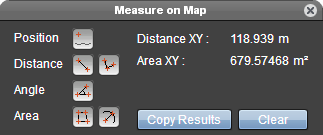For documentation on the current version, please check Knowledge Base.
Map View Component

Compass rose
The compass rose in the left upper corner of the Map component provides all map navigation tools in a single widget.
The mouse-scroll gives access to the zoom function at all time.
Measure on Map
 Using the measure icon from the left lower corner of the Map component the Map measure window can be opened.
Using the measure icon from the left lower corner of the Map component the Map measure window can be opened.
- Position
A single click on the map displays the X,Y coordinates.
The results are available in the publication CRS defined by the Orbit administrator, WGS84 decimal degrees and WGS84 dms.
- Distance
- 1 : A two click measurement. The second click stops the measurement.
The heading is the angle (clockwise) between the north direction and the measured line. - 2 : A multi-click line measurement ending with a double click.
- Angle
The intersection angle of two line measurements (type Distance 1).
- Area
- 1 : A multi-click area measurement ending with a double click.
- 2 : A two click circle measurement. The first click defines the circle center, the second click defines the radius and finishes the measurement.
- Copy Results
Using the “Copy Results” button the displayed measure results will be copied to the clipboard. Results are copied with an id and tab separated ready to paste in your spreadsheets.- Single click button : copy results with headers
- <Shift> + click button : copy results without headers, useful when copying series of measurements.
Measure Results
Coordinate measurements
Absolute coordinate measurements (xy) are expressed in the Publication coordinate system as set by the administrator.
Relative measurements
Relative measurements (distance, line and area) are expressed in an on-the-fly calculated local projection centered around the first measured coordinate. This local projection returns the most accurate metric measure result at all time.
Search on Map
The Search Box drop down on top of the Map Component gives access to all available search engines as configured by the administrator.
Using this entry field it is possible to search for a location and to open the nearest image. A successful search request will center and zoom the map to the returned bounding box and update the left most image view focusing to the requested location. If no bounding box is returned by the search engine the map will be centered only.
Geocode
Enter address or location specifications according the capabilities of the used geocode plugin.
Geocoding services are varied, and implementation cannot be standardized. Therefore Orbit delegate the implementation of a geocoding service to the administrator. Contact your administrator for more information.
Object
Search for Objects via their Attribute values
- Only on map visible vector overlay datasets will be queried
- Use “%” or “*” as wildcards before and/or after the search field
- If multiple matches are found, only the first result will be used to open and focus the nearest image.
Search by XY
Search for XY coordinate.
- Input pattern : <X coordinate><separator><Y coordinate>
- Coordinate separator : space, comma or tab
- Decimal separator : dot or comma, if not used as coordinate separator.
- CRS : the publication coordinate system as defined by the administrator will be used as coordinate crs.
Review the publication crs via the metadata function.
Coverages
Displayed data coverages on Map depend the data type you are using :
Mobile Mapping Photo Positions
The photo positions or recording locations are visible on the Map Component up to a map scale of 1/50,000 :
- recording positions as dots : scale > 1/1,500.
- simplified line representation : scale between 1/5,000 and 1/50,000
Heading and field of view of all Mobile Mapping Views are represented in the pie-slice presentation on the map.
Check the page “MM View > Navigate, Open and Close Views” for an overview of the navigate and open view functions.
Oblique Footprints
Footprints are the only Coverage vectors that can be displayed in the Oblique browser.
To display/hide the footprints on the Map, just tick/untick the “Show Footprints” in the Settings panel of the Toolbar.
While navigating through the Oblique Views, the footprints of the active photo is displayed in the Map. The footprints display is synchronized with the movements of the mouse.
Basemaps
The available basemaps and vector overlays are managed by the Orbit administrator.
Any combination of supported resources can be used as basemap.
Change basemaps
Using the drop-down list from the right upper corner of the Map component it is possible to switch between available basemaps.
Vector overlays
The visibility of available vector overlays can be set via the vector overlay window, opened from the MM View > Sidebar.
It is up to the administrator to define the available vector resources.
Note, a vector dataset may not be visible due to scale limit limitations.
Scale bar
The scale bar is displayed in the lower right corner of the map component.
